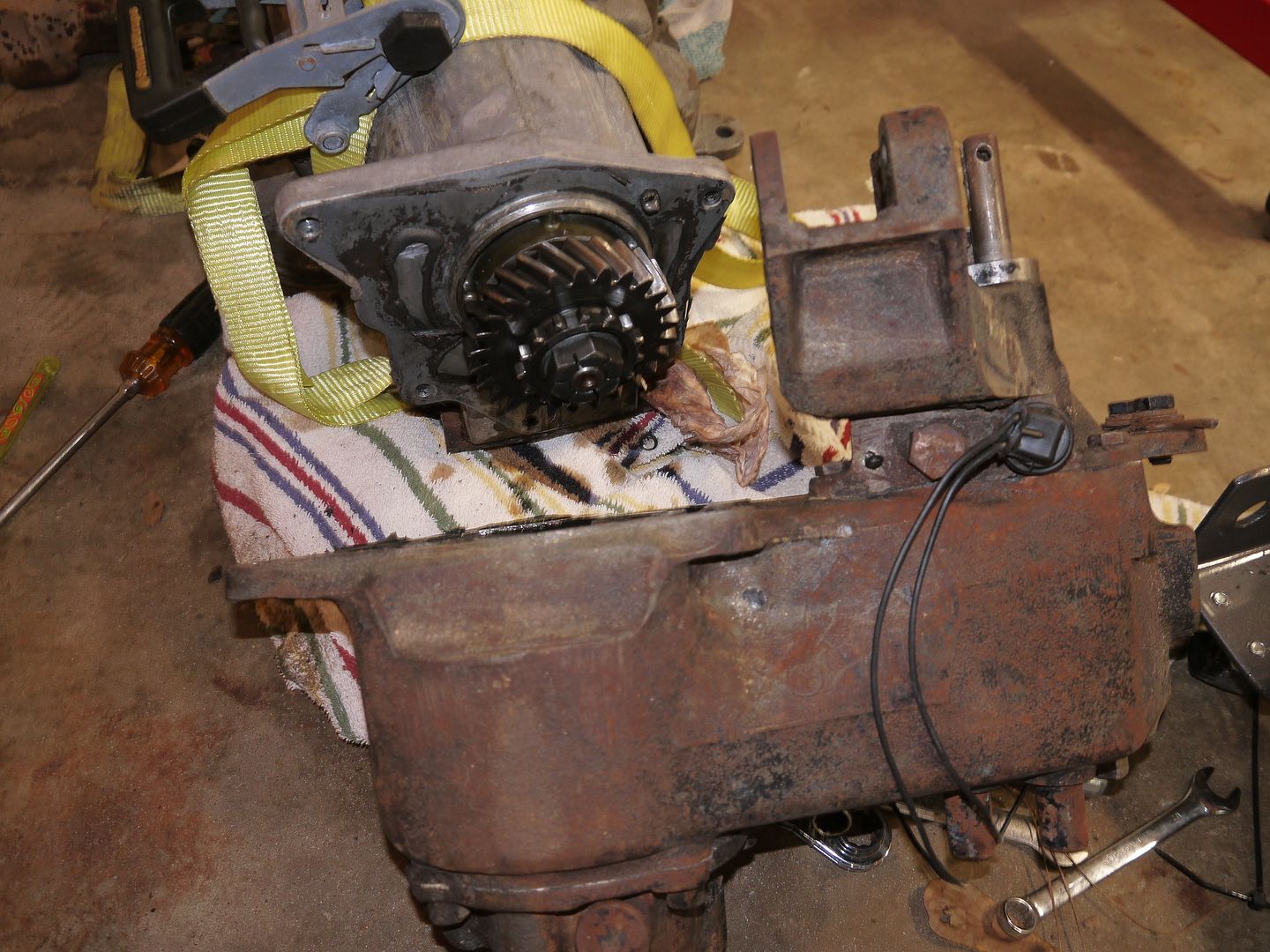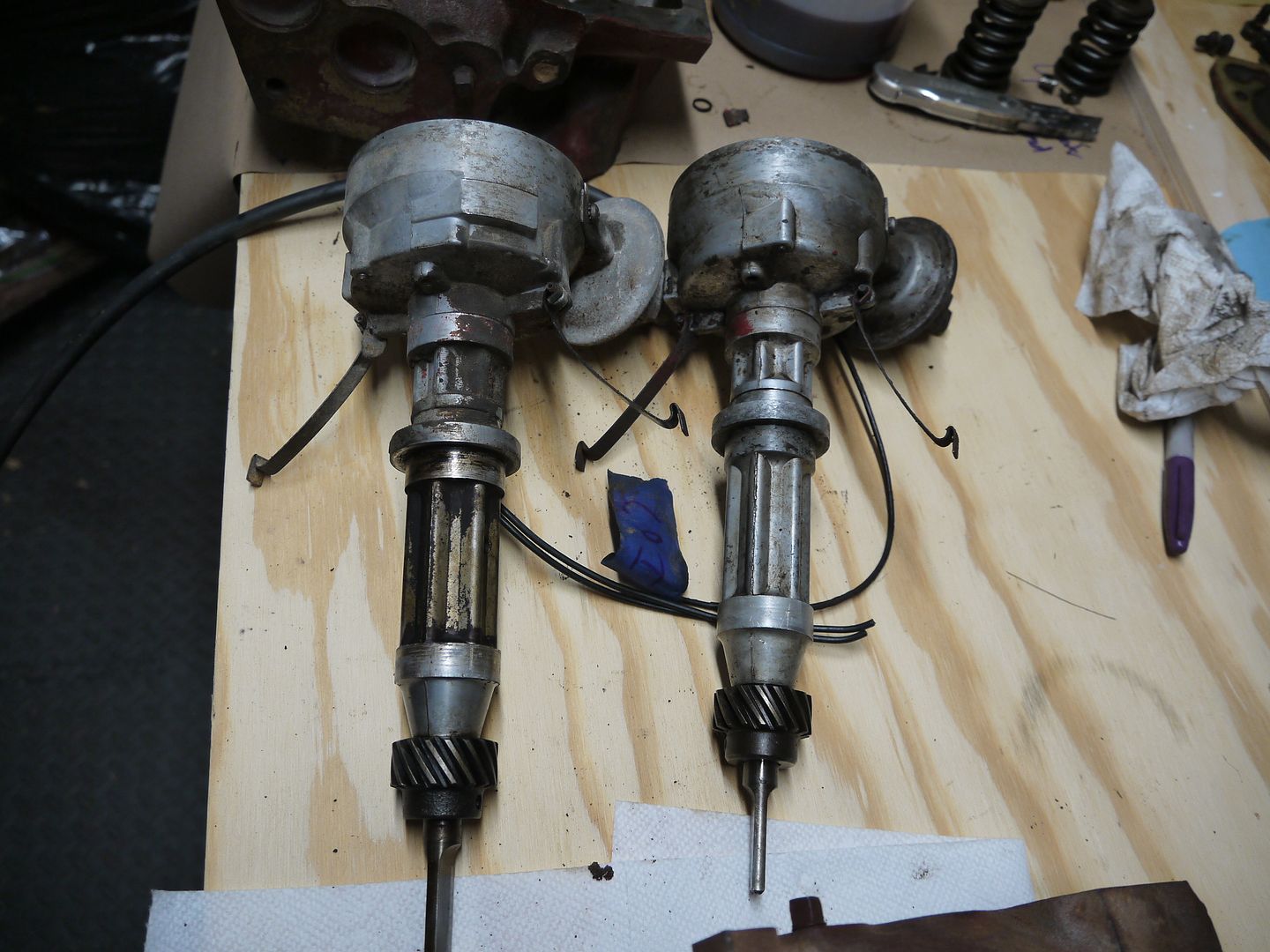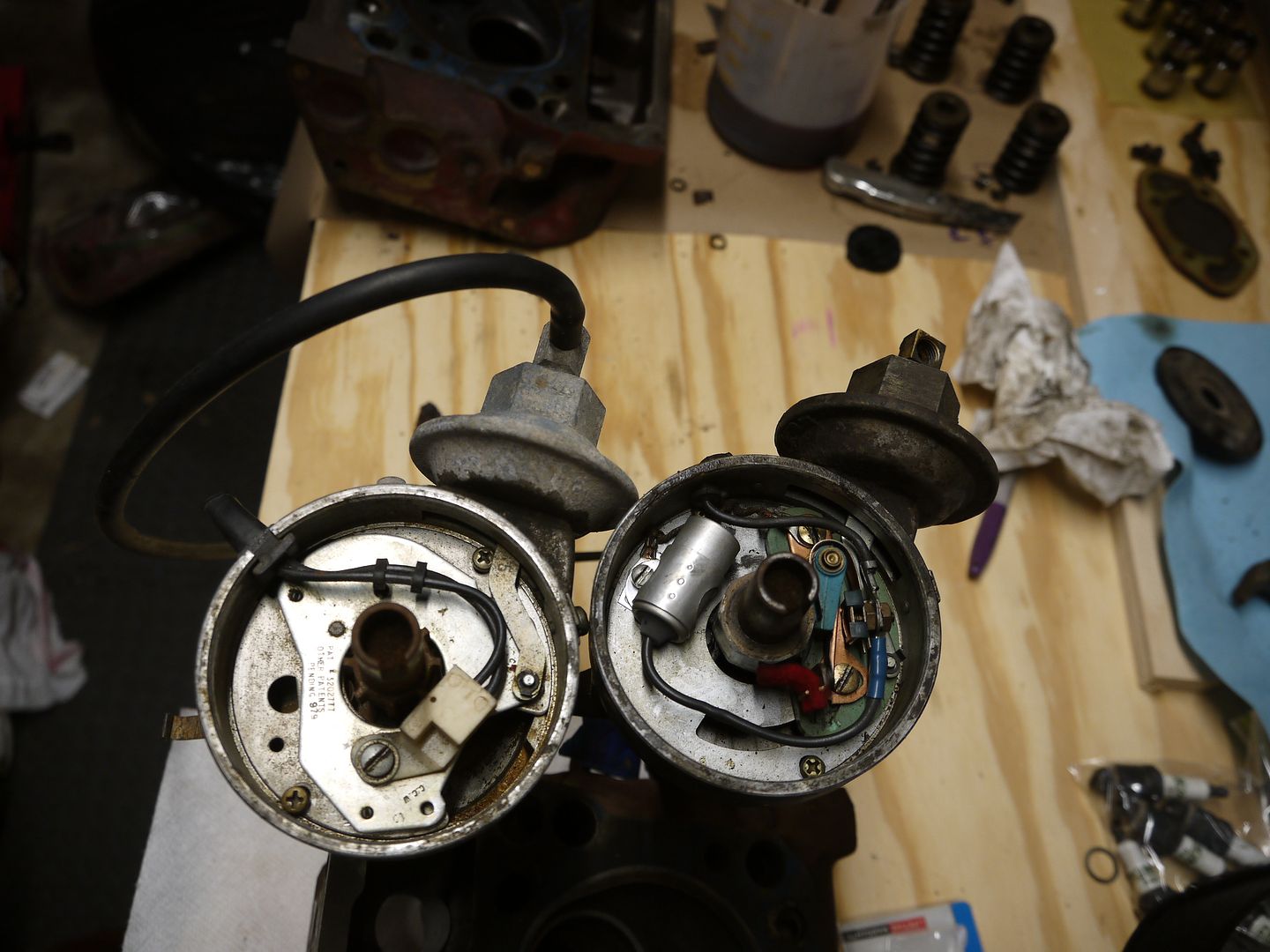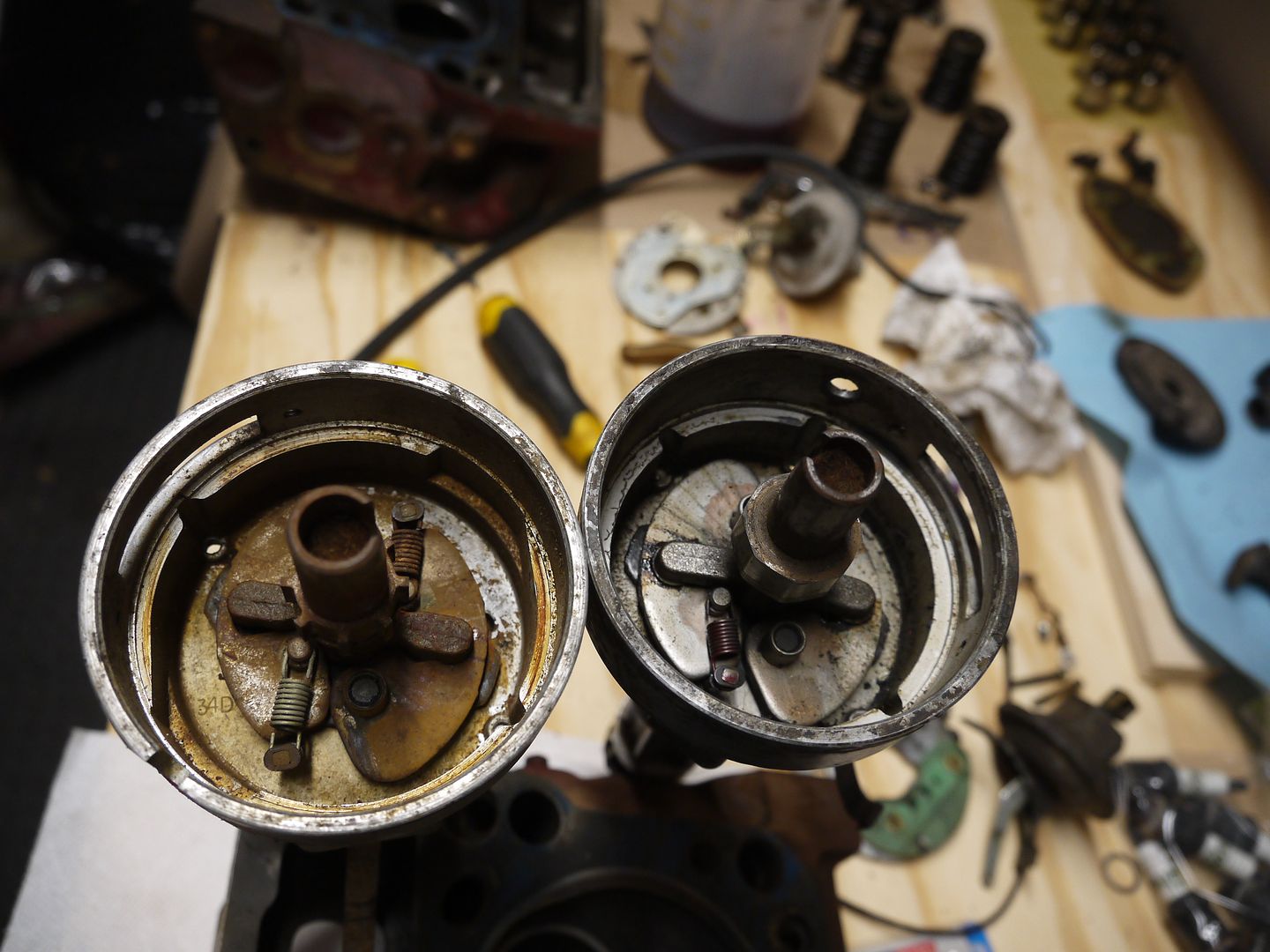
If stored anywhere of a dubiously moist nature, slather that gear with grease. Then bag it.
SAE like grade 8? I've had luck with Lowes....oh and probably TSC......yes lather that gear with grease, put a poly bag over it with a tie wrap, go inside wash your hands and have the chillrens decide what Dude should be sportin' bandage wise ......enjoy your evening....be careful ![]()
mazdeuce - Seth said:Spent some time thinking about what I need to swap from the 304 intake (on the left) to the 345 intake (on the right). I think I just need to swap the big necks and then plumb in a small line for the vacuum advance can. I think. I'll need to stare at it some more.
Vacuum advance typically isn't plumbed to manifold vacuum, especially with more mild engines it usually goes to "ported" vacuum which behaves a bit differently and is provided by a port on the carb. The only difference between them is ported comes on when you open the throttle whereas manifold drops off, they usually come off the line a lot better with the extra advance.

Best bet for your manifold hardware would be an automotive supply. Usually the steel studs are UNC on the block end, and UNF on the other, with brass nuts to suit. Myself I would use a little antiseize and lockwashers on them as well.
In reply to BrokenYugo :
I've spent a few moments with coffee looking at the carbeurator and there isn't a single vacuum port on it that can find. On the 304 the vacuum advance was plumbed with hard line to the manifold. That was with a points distributor which I'm not planning on using, but......that's kind of what I have to work with.
Weird, might be these are meant to run on manifold, some are, I think it has to do with how the mechanical advance curve is setup. Probably wise to use a distributor with the same application as the carb.
It's probably set up to pull timing at idle instead of advance with throttle. I want to say I've seen that before but I'm not getting any hits in the memory bank.
If that's the case, you should probably be careful about future cam selection.
I'd bet there's a plug in the carb somewhere that could be replaced with a nipple if need be.
Ignition. I have two distributors from different generations. At this point I'm looking for simple. I want it to fire and idle so I can troubleshoot all of the other stuff that is SURE to be wrong.
Not sure what happened with the perspective on this picture, but they're the same length.

Points vs....non points? What do we call this? The white thing is essentially a hall effect sensor, right?

And the advance weights. Similar, in fact the weights might be identical, but the springs are different. The advance cans are interchangeable as well.

I know I can buy the Pertronix module and coil and make the more modern system work. $150 and things should make spark with just two wires to hook up. Where I get fuzzy is what it takes to hook up the points distributor as I've never had the need to pull or mess with one of these. Do they just run a single wire to the coil and......done? Hooking up the appropriate switches to power the coil of course which I have to do either way. Or am I missing something? Is there some sort of magic ignition box that needs to be in the system? Should there be something else? I'm basically trying to build something that will be the equivalent of operating the engine on a stand, except the stand will be the truck itself.
Unless you want points for some reason I would go with an electronic system.
I have worked on cars since the late seventies. If I had my choice between completely old and completely new I would go in between. The late 80's GM HEI or the Chrysler systems were reliable and simple. Eliminating the need to adjust points and getting good fire to the plugs made tuning a real pleasure.
I can't find the book on my shelf but this is close: Optimizing Your Ignition, The Doctor's Step by Step Guide, By Dr. Christopher A. Jacobs (PHD. EE) (ISBN 0-9650856-0-0)
I followed a book he wrote in the early 90's or late 80's and just the ignition system I build from a mix of stock GM HEI and Chrysler parts (described in the book) made more horsepower. I will keep searching and if I find the book I will post it. I am pretty sure it was Dr. Jacobs.
I would try using that electronic pickup to fire a 4-pin HEI module. You might get lucky and be able to wire it up the same way as a standard HEI.
Failing that, keep the points distributor and use it to trigger the HEI as shown here: http://speedtalk.com/forum/viewtopic.php?f=1&t=46827&start=30
I like these pictures they bring back lots of memories.
The distributor with points looks to be fairly clean. I would put that back together and give her a go. After all, how long did we run distributors with points before we had any form of electronic ignition?
You have the parts to make a usable ignition for your truck in your hand, might as well learn how they work and use them, learning is the journey here on this project?
You need a coil and possibly a resistor, all of this was on the truck when you got it i'll bet.
The one wire you have hanging out of the distributor goes to the low side of the coil, the minus or distributor side the + side goes to the resistor or the plus side of the battery. You need to ground the body of the distributor. Set the points to .017 thousandths and put power to the coil on the low side and see if it sparks. If it does you have the low side ready to go. The high side is out of the center of the coil, it goes to the center of the cap and the rotor sits on top od the shaft inside the distributor and points the fire to the correct cylinder.
I internet searched this string, connection diagram for a points style ignition got a picture of 500 to show how it is done. You can do this on the bench.
And, AND, the coffee will not get cold. :)
Scott
Isn't having something to tinker on kind of the points?
With the stock motor, lower maintenance is really the only reason to upgrade from points.
You can get a new coil, points/condenser, and a dwell/tach for less than $100. Probably more like $50.
High maintenance aside the thing that makes points suck is that with the exception of startup (that's what the extra terminal on old starters is for, feeding the coil full power during cranking) they don't simply feed straight 12v to the coil, they do it through a current limiting "ballast resistor" (either a big resistor or a resistance wire feeding the coil) so the points last longer than a month. The relatively weak spark you got that way was the push behind everything going transistorized in the 70s, not only had the technology finally gotten good enough, the wider plug gaps and hotter spark was needed for leaner running smog controlled engines.
BrokenYugo said:High maintenance aside the thing that makes points suck is that with the exception of startup (that's what the extra terminal on old starters is for, feeding the coil full power during cranking) they don't simply feed straight 12v to the coil, they do it through a current limiting "ballast resistor" (either a big resistor or a resistance wire feeding the coil) so the points last longer than a month. The relatively weak spark you got that way was the push behind everything going transistorized in the 70s, not only had the technology finally gotten good enough, the wider plug gaps and hotter spark was needed for leaner running smog controlled engines.
Some do and some dont. My 1967 MGB runs 12 volts to the coil full time. Later cars used a ballast resistor and two circuits such that the car starts on 12 volts and runs on 8 or so.
Beauty of points is they will always get you home but transistors will make you walk if they fail.
I don't get why that makes points type ignition "suck".
They do still work well enough to keep the motor running for their intended purpose though, right? (Rhetorical question)
Yeah, modern systems are better in a lot of ways, but by that reasoning this entire IH engine sucks too.
Theoretically I can run 12V through the coil and just sort of zap the E36 M3 out of the points, right? I'm not super concerned with longevity, just getting it to start. There is a 99% chance the ignition will go through an iteration or two before it ever does anything other than run around the block.
mazdeuce - Seth said:That's probably a good idea. Where does one go to shop for random SAE hardware?
I like mcmaster.com. Probably more expensive than Lowe's, but they've got a much wider variety of stuff and i'm a big fan of the convenience of "click a few boxes and it magically shows up my doorstep a few days later".
The downside to studs is that you need more clearance to get the parts off the engine, in some cases it can make the difference between being able to remove/install headers with the engine in the vehicle, vs having to pull it out again.
If you're going with studs, you might want to consider stainless.
I'd use whatever distributor the truck is currently wired for. If it's the points one then there should already be a resistor or resistor wire in the run circuit. For what you're wanting to do I wouldn't worry about vacuum advance (or retard) or really what the centrifugal curve is.
In reply to APEowner :
There are no wires in the truck. None. It's all going to be put back together in time, but it would be extremely psychologically beneficial if I could get it to run long before I get the rest of the truck back together.
mazdeuce - Seth said:In reply to APEowner :
There are no wires in the truck. None. It's all going to be put back together in time, but it would be extremely psychologically beneficial if I could get it to run long before I get the rest of the truck back together.
Hmm. I missed that somehow. In that case, I'd run the points distributor for initial startup. Power to to the plus side of the coil and then a wire from the minus side to the distributor. If you want to get fancy you can add a Ballast Resistor to the circuit.
The points type set-up will be simple and the only thing that can fail would be the coil. The points can be cleaned with sand paper and reset, very simple. If you have a 12 volt coil no need for the resister. Simple is fine unless you really need something more advanced, low RPM truck engine, keep it simple.
You'll need to log in to post.